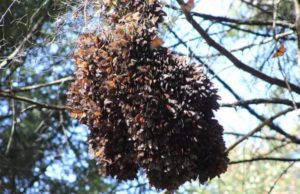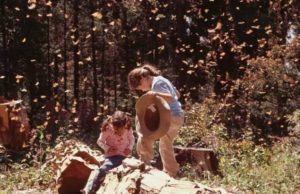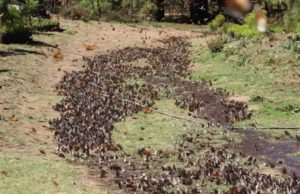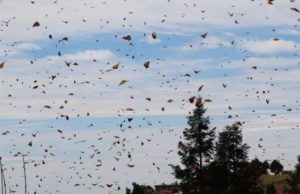Mexico’s biggest threat to monarch butterflies: human indifference
News Category: News and General Discussion
-
One early morning in April, thousands of butterflies rose in front of me like a frenetic whirlwind — a dark mix of heads, thoraxes, legs, and orange wings gracefully irrigated by rivers of black veins framed by tiny white speckles.
In unison, the fifth generation of monarch butterflies — the long-lived ones, the Methuselahs, the migrants without visas — began their voyage back north after having taken winter refuge among the oyamel fir, pine, and oak forests of Mexico’s mighty Sierra Madre Oriental.
At 3,172 meters above sea level, I ecstatically contemplated how those colorful tiny bodies, each weighing less than a gram, raised into the sky with the same resolve with which — chased away by the winter cold and in search of a warmer home — they flew 4,000 kilometers from Canada and the United States to the forests in Llano de las Papas, Michoacán, where I stood that day in awe.
In that sanctuary, the butterflies rose into the air like colorful clouds. Their wings moved like those of fragile, little birds, and backlit by a blinding sun, they blurred in front of my eyes and disappeared into the blue.
Those were only a few of the hundreds of thousands of males who fell in love that day, grabbing the hindwings of females trying to fly while the two wrestled and did their part in an orgy of epic proportions — just as they have done every year since the beginning of time as part of the most sensual nuptial flight I know of.

These tiny insects are determined to recolonize the reproductive areas of their grandparents and great-great-grandparents in the United States at any cost before they die because these butterflies know what is at stake: the survival of the most sublime migration in the entire animal kingdom.
A migration that, sadly, today is vanishing, bit by bit, monarch by monarch, in front of our eyes.
Once, twice or even three times between December and April, year after year for the past two decades, I have traveled from Mexico City to the monarch butterfly’s hibernation sanctuaries in Michoacán and México state. It became a family peregrination.
I spent many visits in monarch territory accompanied by ejidatarios (communal landowners) and indigenous communities — the legitimate owners of the land where the monarch colonies rest during the winter.
And, of course, I also visited with scientists, environmentalists, musicians, journalists, philosophers, business people, philanthropists, lawyers, presidents, state governors, government ministers, diplomats, and politicians of all stripes. Many times, I was with my family; sometimes their families also joined us.
After hiking the monarch mountains over the years with these many companions, I came to understand what Henry David Thoreau meant 168 years ago when he wrote in Walden: “We need the tonic of wildness … We can never have enough of nature.”

I reached this understanding while breathing heavily at thousands of meters above sea level, while silently watching my fellow walkers contemplate — with humility and fascination — the orange mantle formed by fluttering butterflies or an old oyamel fir-covered from root to top by semi-dormant butterflies or that solitary butterfly flapping downward to gently settle on the nearest pine branch.
But what is important isn’t who I went to monarch territory with. What was truly significant was having proved to myself that no matter who we are or where we come from or how we earn a living or what we believe in or what we possess — or even if we are good or bad — we all share that atavistic, urgent need to connect, rejoice and heal in, and with, nature. Even if only for a moment.
Today, I’m convinced that nobody, absolutely nobody who has had the opportunity to discover the miracle of clouds of monarch butterflies in the wild will ever again be the same person. After watching las mariposas, one feels that, after all, life is worth living simply because all human beings are connected by an ancestral passion to loving and caressing nature.
All of my visits with the monarchs have been memorable. Each has been unique, and each has left a stamp on my soul. But perhaps the most endearing was 15 years ago.
So long as I live, I will never forget the emotions that washed over me as those streams of liquid butterflies, like rivers of gold, descended from the sky to quench their thirst with morning dewdrops gifted by the dawn. My daughter — just four years old at the time — and I, with eyes closed, hugged each other, curled up among oyamel firs and oaks as we waited for those orange-black wingbeats to vanish from the morning puddles.
Nor will I forget my haunting visit following the Day of the Dead, when the souls of our ancestors were returning, grafted into colorful butterflies. It was in Sierra Chincua, and I was with a Mexican biologist who has spent far more time than me studying monarchs and with a Protestant Dutch philosopher — El Holandés (the Dutchman) — who became an agnostic.

Searching for the brides of the sun, we climbed “El Candelabro,” an old, giant oyamel fir from which some heartless person had hacked off the trunk when the tree was young. Refusing to die, the tree responded by building 13 new trunks growing side-by-side like giant living Roman columns. I now believe that El Candelabro is the tree that inspired the walking trees of J.R.R. Tolkien’s The Lord of the Rings. I cannot prove that — not yet anyway.
Nor will I forget the visit in 2019, when one of the fiercest defenders of the monarchs proudly guided us as we all waded through rivers of butterflies flowing in and out of El Rosario in Michoacán, the largest and best-protected monarch sanctuary. He was the same local political activist who eventually became a stubborn environmentalist — and whose dead body was left in a muddy pond by his assassins a year later. He was just one of the 76 environmental defenders killed in Mexico between 2019 and 2021, making my country one of the world’s most dangerous for environmentalists.
In February 2020, before the pandemic shook the world, I came back to El Rosario, accompanied by my beloved Mexican butterfly — and romantic partner of the last 35 years. Crouching among the dwarf pines, we suddenly heard in the distance the voice of a noble and luminous Canadian butterfly humming a tune she composed for the occasion. She was accompanied by a gifted lepidopteran guitarist who, open-mouthed, gazed at her with love.
I told myself: here we are with dos mariposas (two butterflies) representing Mexico and Canada — the end and the beginning of the monarch’s long and winding journey.
I still ask myself if all this was true or if was just a dream induced by the images of those fluttering butterflies that we had seen just minutes before against the light after they were awakened from their winter lethargy by the sun’s warm heart.
For many years, I believed that the chemical glyphosate, habitat destruction, and global warming would annihilate the monarch butterfly’s migration. How wrong I was. I am now convinced that the main threat is simply the indifference of human beings.

This mighty migration is endangered mainly by our inability to tackle poverty and the social inequalities that haunt the life of the legitimate owners of the monarch’s hibernation sites.
I’m talking about the tens of thousands of Mexicans — many of them belonging to Mexico’s Mazahua and Otomí ethnic minorities — who, without access to proper education, health services, potable water, electricity, and employment, live in agrarian communities within the 56,259 hectares that comprise the Monarch Butterfly Biosphere Reserve.
Historically dependent on mining and logging, the region’s precarious economy forced many to migrate to the United States while others who chose not to leave their homeland became overwhelmed by the despair brought about by poverty and the violence driven by criminal organizations in the absence of the State’s rule or leadership.
Sure, during these times of cholera, paraphrasing Gabriel García Márquez, we no longer fancy investing money nor political capital in protecting the environment. Most, unfortunately, the government and most companies, philanthropists, and international organizations have all but abandoned the monarch butterfly and the small mountain communities that protect the monarchs’ forests. Will they raise their voices again and open their pockets in these times of need?
This essay is a call for help to all those whom nature has blessed and given a chance to visit the monarch butterfly colonies. It is a call to those who haven’t yet done so to visit them immediately and to economically and emotionally support the local communities within and around these colonies.
It is a call to all of us to work together, hand in hand, with the landowners and guardians of the forests and the butterflies. A call to not steal from our children, grandchildren, and great-great-grandchildren the joy of being connected with their local communities and the butterflies. A call to protect the daughters, granddaughters, and great-great-granddaughters of Danaus plexippus, the winged brides of the sun, and sisters of the moon.

Let us not miss the chance to make peace with ourselves and with all whom we love and with Mother Nature. It might be one of the last chances we have to save the monarch migration, their forests, and the communities with whom they share the land.
Let us not fool ourselves, nor try to fool the next generations either. In this new year just beginning, we cannot miss our chance for reconciling with nature. I dare you to escape for a few days, alone or with your family, to visit any of the 12 community monarch butterfly sanctuaries. You will never regret it, I promise.
To my amigo, Rick Brusca, a.k.a. Dr. Odel Bernini, with thanks.
Omar Vidal, a scientist, was a university professor in Mexico, is a former senior officer at the UN Environment Program, and the former director-general of the World Wildlife Fund-Mexico.


Leave a Reply